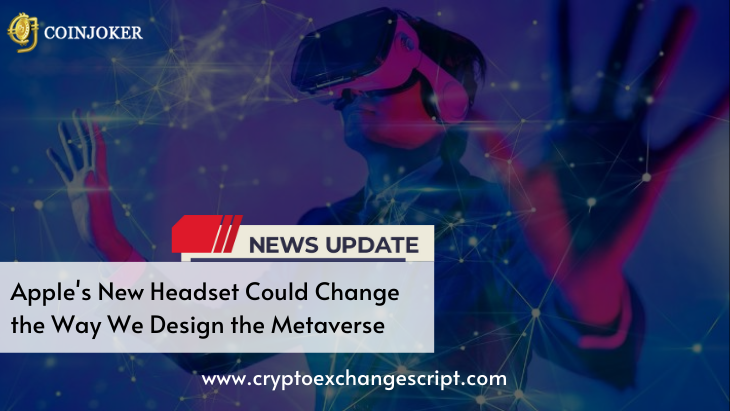
Apple's New Headset Could Change the Way We Design the Metaverse
 Jun 06, 2023
Jun 06, 2023
Apple on Monday released its new Vision Pro mixed reality headset, tossing its hat into the already-saturated arena of immersive digital technology. Taking on heavy-hitting competitors like Microsoft's Hololens, Meta's Oculus and Magic Leap, Apple has pegged its device as "a revolutionary spatial computer that seamlessly blends digital content with the physical world, while allowing users to stay present and connected to others."
The sleek device, an expansion of Apple's existing hardware lineup, is controlled by a user's eyes, hands and voice inputs. Most impressively, Apple says that the device will "interact with digital content in a way that feels like it is physically present in their space," meaning its high-resolution device can seamlessly project content into a user's physical space.
"Vision Pro is years ahead and unlike anything created before – with a revolutionary new input system and thousands of groundbreaking innovations," said Apple CEO Tim Cook in a press release. "It unlocks incredible experiences for our users and exciting new opportunities for our developers.”
The device carries some impressive specs: it boasts 23 million pixels across two displays, features a custom Apple silicon chip and introduces VisionOS, a spatial operating system that offers a three-dimensional interface, releasing applications from the boundaries of traditional screens and bringing them into real-world spaces. To start, Apple says that users can play over 100 Apple Arcade games, though the Silicon Valley giant says that the device "makes new types of games possible with titles that can span a spectrum of immersion."
Additionally, the device includes what Apple has dubbed "EyeSight," which allows the user to see other people while also displaying the user’s eyes, taking away the creepiness that often comes with wearing a headset.
While some purists may say that the product borrows ideas from existing devices, its release is meaningful for the development of our immersive digital future. Not only is the Apple App Store one of the most lucrative platforms for developers, Apple also has an expansive and passionate customer base, recently announcing that it has surpassed two billion active devices.
While Apple explicitly avoided the use of words like "virtual reality" or "metaverse" in its marketing materials, it's clear that this technology represents a new paradigm for immersive digital experiences and will likely shape the way we build in Web3.
Designing The Blueprint For a Digital Future
Previous discussions about the metaverse have been vague, maybe intentionally so, and typically centered on the idea of a single immersive, digital space where users can converge. The term, originally coined in 1992 by science-fiction author Neal Stephenson, has been co-opted by brands and virtual world-building platforms to point to their version of this concept, though data suggests that none of these versions have yet to stick.
As my colleague Cam Thompson wrote in April, the execution of the metaverse so far has been "multiple spaces, centralized or decentralized, where users can access multiple different metaverse experiences, each siloed away from the other without interoperability."
Many blockchain-native companies and funds are still invested in its development and continue to make meaningful progress, though it appears that the path forward for the conceptual metaverse remains paved with potholes, as evidenced by Web3 giant Animoca Brands recently scaling back its metaverse funding target.
Apple's entry into virtual tech may signal a meaningful shift for an otherwise stagnant space. It is among the largest tech companies in the world, though historically it has been quiet when it comes to discussions about blockchain technology or the future of Web3. While its App Store supports some blockchain games, it has simultaneously signaled a rejection of Web3 by refusing to exempt NFTs from its 30% “Apple Tax” on in-app purchases.
Cook has previously expressed skepticism over the concept of the metaverse – or at least the amorphous way in which the metaverse has thus far been described.
"I always think it’s important that people understand what something is,” Cook told Dutch publication Bright in September 2022 when rumors first began to swirl that Apple was eyeing virtual reality. “And I’m really not sure the average person can tell you what the metaverse is.”
Cook has previously dismissed immersive digital and virtual technology as something that can be used for short periods but "is not a way to communicate properly."
"I don't think you want to live your whole life that way," he told Bright, though he has been more bullish on the idea of augmented reality (AR), calling it "a profound technology that will affect everything."
Without using the word, the Vision Pro is Apple's decisive statement on the future of the metaverse. By creating the technological framework, Apple has set the bar for what immersive digital experiences can – and should – look like, opening the door for developers within and outside of the Web3 space to create products that fit within its realm.
"Apple's Vision Pro shows that the future of the Internet is 3D," said Kenneth Landau, CEO and co-founder of cloud-based metaverse platform Mytaverse. "Tim Cook cemented this theory when he compared Vision Pro to the next wave of computing, following the Mac and iPhone."
"It builds upon theories built by the metaverse industry over the past few years," added Mytaverse co-founder and CTO Jaime Lopez.
For example, at Apple's Worldwide Developers Conference on Monday, the company introduced its take on digital personas, a concept central to Web3. The device uses machine learning and the front sensors on the device to create a natural-looking and dynamic digital avatar that mimics a user's facial and hand movements.